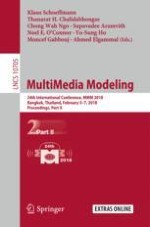2018 | Buch
MultiMedia Modeling
24th International Conference, MMM 2018, Bangkok, Thailand, February 5-7, 2018, Proceedings, Part II
herausgegeben von: Prof. Dr. Klaus Schoeffmann, Thanarat H. Chalidabhongse, Chong Wah Ngo, Prof. Dr. Supavadee Aramvith, Noel E. O’Connor, Yo-Sung Ho, Moncef Gabbouj, Prof. Ahmed Elgammal
Verlag: Springer International Publishing
Buchreihe : Lecture Notes in Computer Science
